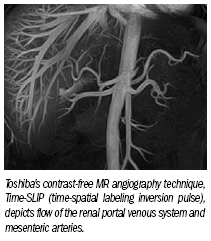Patient-focused design gives direction to Toshiba R&D
Efforts to increase comfort result in speedier exams and improved image quality.
The MR industry today is focused on improving efficiency and accuracy while mitigating issues around imaging claustrophobic and bariatric patients. Toshiba's strategic approach to address these issues is twofold: listen to our customers to deliver technology that meets their needs, and develop high-quality MR systems with patient-centered technology to improve exam efficiency through increased patient comfort.
Because exams are easier to complete in a timely manner when patients are more relaxed, Toshiba's Titan 1.5T MR large, wide-bore system was designed to increase comfort. This has resulted in more efficient imaging of all patients, especially those who are claustrophobic or bariatric. With its ultrashort open bore, Titan also offers the industry's largest clinical field-of-view (55 × 55 × 50 cm). The open bore's larger diameter enables customers to scan bariatric patients with greater ease.
During exams, unnecessary time can be spent moving patients to change coils. Toshiba has dramatically reduced the need to reposition patients with its Atlas coil technology, which is integrated into the table. This feature also enables feet-first imaging for feet-to-shoulder exams, another example of Toshiba's strategic approach to patient comfort.

Pianissimo, our proprietary technology that reduces noise by up to 90%, makes Toshiba's MR systems the quietest available. Lower noise levels with Pianissimo reduce the chance that patients will be startled by the sudden activation of gradient coils. This results in fewer motion artifacts, which improves image quality. Useful for imaging pediatric patients, Pianissimo helps technologists image patients more successfully and reduces the number of repeat exams needed, thereby shortening overall exam times.
Investing resources to develop contrast-free MR imaging techniques more than 11 years ago proved advantageous for patients and providers when a connection was discovered between gadolinium and nephrogenic systemic fibrosis/nephrogenic fibrosing dermopathy (NSF/NFD). The healthcare industry then had immediate access to contrast-free MR angiography (MRA) techniques like fresh blood imaging (FBI) for evaluating peripheral vascular diseases of the lower legs and extremities; contrast-free improved angiography (CIA) for easier acquisition and superior imaging of smaller vessels; time-space labeling inversion pulse (Time-SLIP) for evaluating hemodynamic velocity and functional assessments and visualization of vascular structures; and time-space angiography (TSA) to create noncontrast time-resolved imaging with high temporal resolution. Not only are contrast-free techniques safer for patients with known renal compromise, they also reduce setup time to speed the overall MR exam without compromising image quality.
Staying true to a customer- and patient-focused philosophy, Toshiba is now developing an open-bore 3T MR system (a work-in-progress). Early reports indicate it will be the most comfortable, flexible, and efficient 3T MR scanner available. It will offer a 71-cm aperture, Pianissimo noise reduction technology, and other patient-centric features.
The strategy of listening to customers and developing patient-centered technologies to meet the needs of today's healthcare providers resonates in a healthcare environment in which everyone is expected to do more with less.
Could Ultrafast MRI Enhance Detection of Malignant Foci for Breast Cancer?
April 10th 2025In a new study involving over 120 women, nearly two-thirds of whom had a family history of breast cancer, ultrafast MRI findings revealed a 5 percent increase in malignancy risk for each second increase in the difference between lesion and background parenchymal enhancement (BPE) time to enhancement (TTE).
MRI Study Suggests Shape of White Matter Hyperintensities May Be Predictive of Cognitive Decline
April 7th 2025Emerging research demonstrated that cognitive declines in memory, executive function and processing speed domains were associated with irregular shape of periventricular/confluent white matter hyperintensities.
Can Abbreviated MRI Have an Impact in Rectal Cancer Staging?
April 4th 2025Abbreviated MRI demonstrated a 95.3 percent specificity for rectal cancer and provided strong agreement with the full MRI protocol for T staging and detection of extramural venous invasion, according to newly published research.